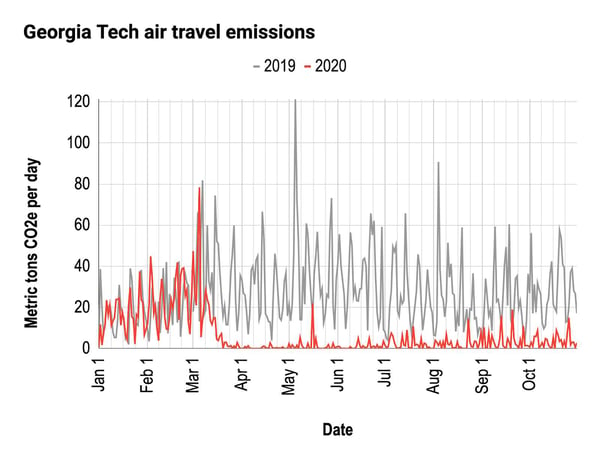We have all learned new work routines during the pandemic. How have these new behaviors impacted greenhouse gas emissions, and how can we learn from our new routines to help curb global warming? Lalith Polepeddi and Dr. Kim Cobb of the Global Change Program at the Georgia Institute of Technology have some ideas.

Air travel is a source of greenhouse gas emissions that is growing rapidly, increasing roughly 6% per year in the US and globally. Globally, aviation emissions account for just 2% of global greenhouse gas emissions, but it’s important to note that if aviation were a country, it would be the sixth-largest emitter.
It’s difficult to quantify aviation emissions for a given state or country because air travel, by definition, crosses borders. That’s why the Drawdown Georgia research team chose to leave out aviation emissions when they set out to calculate emissions produced by transportation in Georgia, despite the fact that Atlanta’s Hartsfield-Jackson airport is the busiest in the world.
COVID-19 has caused dramatic reductions in air travel worldwide. We realized we had a unique opportunity to analyze emissions reductions related to air travel at a large research university, as an extension of the Drawdown Georgia research. We looked at Georgia Tech’s flight records in 2019 versus 2020 and used a calculator published by the University of British Columbia to convert individual flight mileages to CO2-equivalent (hereafter CO2e) emissions.
Our results show that, on average, Georgia Tech aviation emissions account for 9,300 metric tons of CO2e per year. This is equivalent to the emissions produced by 2,000 cars over one year.
Efforts to curb the spread of COVID-19 led to the cancellation of almost all work-related travel starting in mid-March 2020. Between April and October 2020, Georgia Tech's aviation emissions dropped by 5,600 metric tons CO2e (92% reduction) compared to the same time period in 2019 and saved over $5.6 million on flight tickets alone over this seven-month period.

Fig caption: Georgia Tech aviation emissions during COVID-19 (red) compared to the same time period in 2019 (grey)
To get a statewide perspective, we then expanded our analysis beyond Georgia Tech and estimated that aviation emissions from institutions of higher education in Georgia account for over 83,000 metric tons CO2e per year.
Looking ahead to when COVID-19 eases, a reduction in air travel is possible by continuing low-carbon work behaviors that were effective during the pandemic in the shift to remote work. For example, at Georgia Tech we found that single-day flights comprised 29% of all flights and generated 15% of all air travel emissions in 2019. Extrapolated across institutions of higher education in Georgia, if all single day flights were replaced with teleconferencing, as they have been during COVID-19, institutions could reduce air travel emissions by over 1,400 metric tons CO2e per year, and save millions of dollars on flight ticket costs, hotel stays, ground transportation, and per diem expenses.
We still need to fully understand the unique factors that drive air travel at each university in order to provide more recommendations to reduce carbon emissions, but these initial estimates suggest that institutions can reduce the climate impact of air travel through a coordinated set of policies as part of their climate action plans informed by low-carbon behaviors that were effective during the pandemic.
Institutions of higher education can and should play a role in helping Georgia achieve emissions reductions. Aviation is an important solution to include in Georgia’s climate action portfolio, as it is in regional, national, and global agendas.
1 The majority of flight ticket costs are associated with Georgia Tech's sponsored research programs. A smaller fraction reflects state funded travel.
2 A major driver of Georgia Tech's aviation emissions is its research activity. We extrapolated Georgia Tech's aviation emissions to three other institutions in the state with very high research activity - Emory, Georgia State University, and University of Georgia - and used the number of faculty at each institution as a scaling factor for aviation emissions. We used this estimate as a proxy for aviation emissions generated by all institutions of higher education in Georgia.







.jpg)
